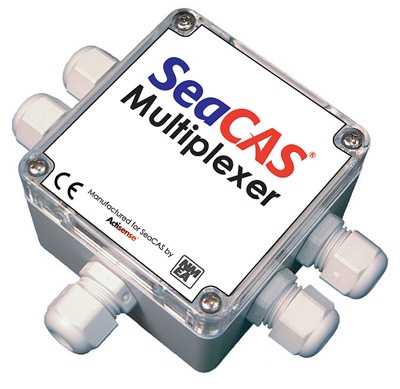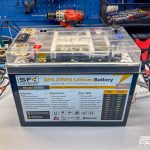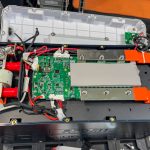AIS, this ‘n’ that #5

Y-tronic just introduced a slick looking combo GPS and tuned AIS antennas meant especially for Class B transponders. Y-tronic is also showing the Trueheading Class B as FCC approved. I wish that was true but think it’s a mistake based on SRT’s pulled-back approval. I still don’t know what’s up with the FCC and Class B; anyone?
Meanwhile, the new Barcelona World Race (two-handed non-stop round the world…exciting) has amended its Notice of Race rules to permit Class B in lieu of Class A transponders. Interestingly, a racer must use AIS in the Med, around the Horn, and within 50nm of the gates, and use is “recommended at other times when ships may be encountered”. (Thanks to Adolfo at Atlantic Source for this!)
And Fred Pot at SeaCAS continues to improve his line of high quality true dual-channel AIS receivers, what with direct connect cables for Raymarine and Furuno plotters, a powerfully spec-ed multiplexer (below, built by Actisense), and now a significant price cut on all three receiver models. But Fred’s pretty leery about Class B, as expressed on his FAQ page. I share many of those concerns, which I summarized in a March PMY column. However, I do question Fred’s assumed 4nm range for Class B. I’m hearing better from Europe, though I haven’t heard much. I’ve got a nice apple for the first company that can loan me a U.S. approved Class B transponder to try out!














It is nice to see better US availability for the Actisense NMEA product. The cost for obtaining these from the UK directly had been too expensive and now the pricing is looking more reasonable.
I’m interested if anyone has had a chance to compare the Actisense combiner with the latest Brookhouse AIS combiner. The pricing and features are roughly equivalent. The option of the repeater display on the Brookhouse is interesting, but pushing the data around accurately and correctly is obviously most important.
I’ve been using the Raymarine Seatalk/NMEA combiner with poor results. GPS data to my Icom comes and goes and Raymarine has already replaced (for free) one failed unit. The low price has not been worth the frustration.
We have had good luck with the Shipmodul Miniplex-Lite USB (supports 3 NMEA inputs including AIS) and the Shipmodul MiniPlex-42 Bluetooth Multiplexers.
http://www.shipmodul.com
I think Fred is being a bit pessimistic and I can’t agree with everything he says, however one point stands out a mile: even if the big ships CAN see you, are they likely to do anything about it? Unless they’re on the high seas, chances are they’ll be in a restricted channel or busy dodging other big stuff! So, stay out of their way!
In the Class B trials in the Solent, UK last year, I recorded repeatable ranges of 8nm from a RIB, and more from one of the lifeboats, even after it had swung around the other side of the Isle of Wight. There is a report on the MCGA web site if you want to read it.
All Class A’s SHOULD be able to understand a Class B position report (msg18) as its been in the standard from the start, its just the static data (msg24a & 24b) that may not be decoded if it hasn’t been upgraded. Hardly a critical failing.
Is there a Class A or a plotter on the market with a Class B filter? I’ve not seen one yet.
It is true that Class B will only Tx if the channel has room for it, but the USCG simulations clearly show that the chances of a Class B being blocked are low. It was, after all, one of the fundemental principles of the Class B design, that it should not de-grade the Class A performance.
Please Fred, don’t denigrate a system before its even been deployed properly! We all know it isn’t perfect (never could be) but its a lot better than nothing.
I’ve heard from another Class B tester, this one in the U.S., who says they saw 10nm and greater ranges, even though they were using “crappy transmitters”.
Del, I tried to find your report on the MCGA site, but no luck. Can you give a link?
1) Considering the transmissions have to be perfectly timed as each radio consumes their slot, without interfering with others, isn’t it undesirable to have too great a range and the associated propogation delay trouncing other transmitters? Maybe the designers intentionally desire that implimentations don’t attempt to exceed the target ranges ?
After all, this isn’t wi-fi, where range is everything for the consumer of the service.
2) Following the thread “even if a big ship can see you” stay out of their way. I would think
a) Now that they know you have AIS yourself (you are transmitting after all), they might especially have an unreasonable expectation you know they are their and will will stay out of the way? (unreasonable … maybe your crew isn’t paying attention to the display)
b)I wonder if the big ships give some real consideration to AIS targets that are not moving, mechanical failures, at anchor, etc. With radar it’s not always clear that your boat is stationary, where with class-b, maybe when your vessel is disabled or stationary for some reason you will get some additional courtesy ?
b393:
1: Spot on, old chap, got it in one!
2: Maybe – there is a ship off the south coast of Portugal at the moment involved in recovering the wreck of a very old RN warship using an ROV which has as its AIS destination “1nm clearance please”.
I’m not entirely sure of the legality of this, but it certainly gets the message across!
Ben: I’m really sorry, I’ve scoured the MCGA web site as well and can no longer find that report, I’ll see if I can find a copy elsewhere for you.
So is there an AIS product (ideally Fred’s AIS/DGPS combo – hint) that can just plug into a NMEA2000 backbone? ShipModul builds quality hardware in my opinion, but is anyone else getting tired of fooling with 0183 multiplexers when we have an established alternative?
(Yes, I’m aware of the ridiculous costs of getting NMEA2000 certified…otherwise I think Meindert (ShipModul) would have something cool out 🙂
Robert
On the whole AIS range issue – don’t forget the range is not directly ‘designed’ into these products. The transmitter power, VHF antenna, antenna height & location along with atmospheric conditions all have a significant impact on the resulting transmitter range.
As such tests carried out on one vessel, on one day can’t give a full picture of the ‘average’ range.
marinate:
Very true. However the UK trial used over 8 vessels of different types – RIB’s, RNLI Lifeboats, 36 foot yachts etc. interacting with the cross-Solent ferries (on Class A obviously) so the only restricting factor was that it only covered a 6 hour period during the day.
The results largely tallied with the more informal trial in Oban by the NLB and the North Sea tests on the German research vessel “Gauss”, so I think I can see a trend emerging…..